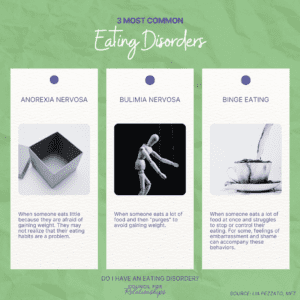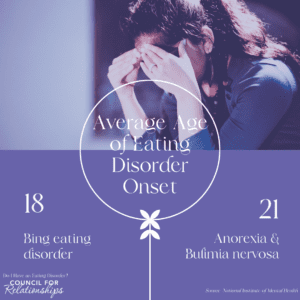Exploring Common Forms of Eating Disorders
Eating disorders are often marked by a fear of gaining weight or a lack of control over eating habits. Yet, they are complex conditions that are more than just challenges related to food. That is why no blog (even this one) can adequately help you answer the question, “Do I have an eating disorder?”. However, understanding the basics of the most common forms of eating disorders is a first step towards healing.
This blog discusses common forms of eating disorders such as anorexia, bulimia, and binge eating. It highlights signs indicating someone is struggling, including physical and emotional symptoms. These complexities affirm the need for personalized treatment plans made by mental health professionals.
This blog is not intended to help you self-diagnosis. However, addressing these disorders starts with understanding them better. Healing and recovery are possible.
What is an eating disorder?
There are many eating disorders, but the three most common are anorexia, bulimia, and binge eating disorder.
Anorexia nervosa is marked by a persistent refusal of food, excessive fear of weight gain, refusal to maintain minimally normal body weight, disturbed perception of body image, and an absence of at least three menstrual periods (this is known as “amenorrhea”).
Bulimia nervosa is marked by someone eating a lot of food and then “purging” to avoid gaining weight.
Purging can occur in various ways. Some people make themselves vomit, while others take laxatives or other medications to speed up digestion. Another method is exercising excessively to burn off calories. These behaviors can also stem from a feeling of loss of control.
Binge eating disorder is when someone eats a lot of food at once and struggles to stop or control their eating. For some, feelings of embarrassment and shame can accompany these behaviors.
Are eating disorders genetic?
Research suggests that genetics and family history play a significant role in the development of eating disorders. This means that eating disorders are often passed down through generations.
If you have a family history of eating disorders, it doesn’t automatically mean they will you will develop one. Conversely, a diagnosis of an eating disorder can occur even if you have not previously shown these behaviors or if you do not have a history of eating disorders in your family.
Family history is just one factor that may contribute to the development of an eating disorder. Environmental and psychological factors can also contribute to the development of an eating disorder.
Anyone can develop an eating disorder. Reaching out for support and help if you feel you are struggling with an eating disorder is critically important.
How do I know if I have an eating disorder?
Have you ever wondered:
“Do I have an eating disorder?”
“Are my eating habits unhealthy?”
“Am I binge eating, or do I not have self-control?”
You’re not alone. 5% of the population is affected by eating disorders. And there are a lot of misconceptions about those who are suffering from these disorders.
I encourage you to try and challenge these narratives and examine where they may come from. For example, some people think eating too much (or too little) food is a weakness instead of seeing it as a challenging health condition.
Eating disorders are not just about wanting to look a certain way or being out of control. They are complex issues that go beyond appearance and self-control. Often, people develop eating disorders as a way to cope with deeper issues. Many cases have shown that eating disorder behaviors often emerge as a way to cope with trauma.
If you feel like you can’t control how you eat or feel about your body, it’s important to ask for help.
Where and how can I find help?
Living with an eating disorder is difficult. Without proper support, it can progress and negatively impact both your mental and physical health.
Getting help is important if you feel like you can’t control how you eat or feel about your body. Recovery from an eating disorder is a lifelong process that takes time and preventative practices.
Treatment such as therapy and working with dieticians can help. Further, support systems are important in one’s recovery. Support from loved ones and family also plays a major role in one’s recovery.
It can be hard to acknowledge that you may need help and then ask for it. However, do not isolate yourself and the issues you are facing. Our experienced clinicians can support you on your healing journey.
In addition to Council for Relationships, the following Philadelphia-area treatment centers offer treatment options and other helpful resources:
- The Renfrew Center
- Belmont Behavioral – Eating Disorder Program
- Seeds of Hope
- Clementine Cherry Hill
- Recovered and Restored Eating Disorder Therapy Center
You do not have to face this on your own!
About the Author
Lia Pezzato, MFT, is a Staff Therapist at Council for Relationships. Contact her to book a therapy appointment with Lia if you’re facing mental health challenges.
Lia helps people who are coping with eating disorder symptoms in New Jersey and Pennsylvania. Tell your friends and family members to reach out to her for support. She can help you feel good, find happiness, and other personal goals.
Your mental (and physical) health is important to us. If you are looking for individual, couples, or family therapy or psychiatry services, see our Therapist & Psychiatrist Directory for CFR therapists or psychiatrists near you.
If this is an emergency, dial 9-1-1.
More from CFR
Did you enjoy this blog? Our expert therapists, psychologists, and psychiatrists offer much more to explore! Check out the CFR Expert Voices blog for great mental and emotional health advice and insight. To get first access to our Expert Voices blog, join our mailing list!



